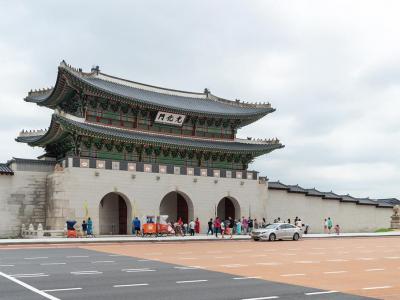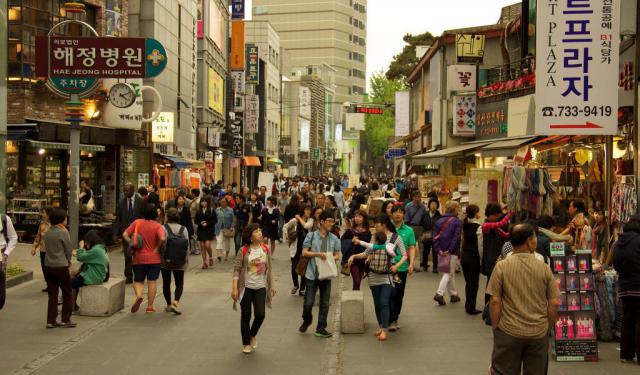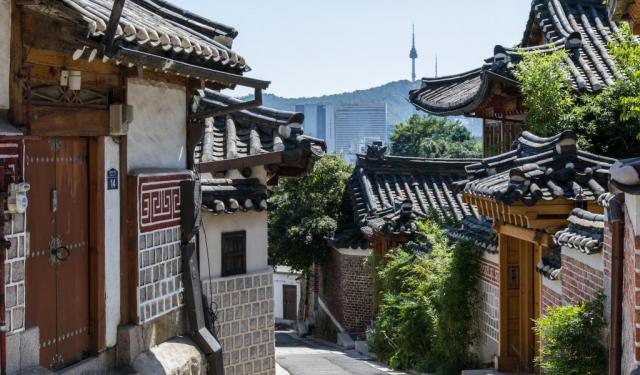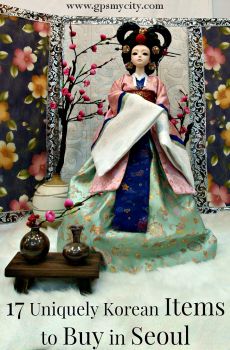Gwanghwamun Gate, Seoul
Gwanghwamun Gate is main entrance into Gyeongbokgung Palace, and so it is also the largest and most imposing of the four gates. It features three grand arched gates--the center gate was reserved for use by the king, while the crown prince and royal officials used the other two smaller arches.
The tall granite structure of the gate supports the ornately decorated wooden gate tower, which watches over the city. The pavilon housed a bell that announced the time of the day to the city. Two majestic Haetae sculptures guard the gate. These mythical lion-like beasts were stationed there to protect the palace against fire.
Gwanghwamun Gate was one of only four gates constructed in the palace walls. They were originally constructed in 1395 during the reign of King Taejo of the Joseon Dynasty. But the gates and walls have been through many cycles of destruction and reconstruction.
It was destroyed by fire during the Imjin Wars in 1592 and laid in ruins until it was rebuilt in 1867. In 1926, the Japanese government moved Gwanghwamun Gate. The double-roofed wooden pavilion on the gate was destroyed during the Korean War. The gate was moved again in 1968.
Gwanghwamun Gate was moved back to its original location in 2006, and the restoration was completed in 2010. The restoration included recreating the base with traditional materials, recreating the original wooden pavilion structure with Korean pine, and recreating the wooden nameplate.
The area in front of Gwanghwamun Gate is known as Gwanghwamun Plaza. Here, visitors can watch the impressive royal changing of the guard ceremony. This ceremony is held daily, every hour, on the hour, from 10:00 to 15:00.
Tip:
The square housing the gate contains fountains, statues and sculptures that are also definitely worth seeing, plus an underground museum dedicated to Sejong the Great, the 4th king of the Joseon Dynasty.
The tall granite structure of the gate supports the ornately decorated wooden gate tower, which watches over the city. The pavilon housed a bell that announced the time of the day to the city. Two majestic Haetae sculptures guard the gate. These mythical lion-like beasts were stationed there to protect the palace against fire.
Gwanghwamun Gate was one of only four gates constructed in the palace walls. They were originally constructed in 1395 during the reign of King Taejo of the Joseon Dynasty. But the gates and walls have been through many cycles of destruction and reconstruction.
It was destroyed by fire during the Imjin Wars in 1592 and laid in ruins until it was rebuilt in 1867. In 1926, the Japanese government moved Gwanghwamun Gate. The double-roofed wooden pavilion on the gate was destroyed during the Korean War. The gate was moved again in 1968.
Gwanghwamun Gate was moved back to its original location in 2006, and the restoration was completed in 2010. The restoration included recreating the base with traditional materials, recreating the original wooden pavilion structure with Korean pine, and recreating the wooden nameplate.
The area in front of Gwanghwamun Gate is known as Gwanghwamun Plaza. Here, visitors can watch the impressive royal changing of the guard ceremony. This ceremony is held daily, every hour, on the hour, from 10:00 to 15:00.
Tip:
The square housing the gate contains fountains, statues and sculptures that are also definitely worth seeing, plus an underground museum dedicated to Sejong the Great, the 4th king of the Joseon Dynasty.
Want to visit this sight? Check out these Self-Guided Walking Tours in Seoul. Alternatively, you can download the mobile app "GPSmyCity: Walks in 1K+ Cities" from Apple App Store or Google Play Store. The app turns your mobile device to a personal tour guide and it works offline, so no data plan is needed when traveling abroad.
Gwanghwamun Gate on Map
Sight Name: Gwanghwamun Gate
Sight Location: Seoul, South Korea (See walking tours in Seoul)
Sight Type: Attraction/Landmark
Guide(s) Containing This Sight:
Sight Location: Seoul, South Korea (See walking tours in Seoul)
Sight Type: Attraction/Landmark
Guide(s) Containing This Sight:
Walking Tours in Seoul, South Korea
Create Your Own Walk in Seoul
Creating your own self-guided walk in Seoul is easy and fun. Choose the city attractions that you want to see and a walk route map will be created just for you. You can even set your hotel as the start point of the walk.
Seoul Introduction Walking Tour
The bustling capital of South Korea, Seoul, seamlessly blends modern innovation with a more than 2,000-year history. Remarkably, until 1972, the city was claimed by North Korea as its de jure capital and even specified as such in its constitution.
Seoul was founded in 18 BC by the people of Baekje. The three ancient kingdoms of Korea – Baekje, Goguryeo, and Silla – fought over its... view more
Tour Duration: 2 Hour(s)
Travel Distance: 3.5 Km or 2.2 Miles
Seoul was founded in 18 BC by the people of Baekje. The three ancient kingdoms of Korea – Baekje, Goguryeo, and Silla – fought over its... view more
Tour Duration: 2 Hour(s)
Travel Distance: 3.5 Km or 2.2 Miles
Insa-dong Walking Tour
Originating 500 years ago as a residential quarter for government officials, today's Insa-dong is a buzzing shopping and dining district in Seoul where the past meets the present. During the Japanese occupation of the country in the first half of the 20th century, wealthy Koreans were forced to move out and sell their belongings, at which point the district became a center of antique trading.... view more
Tour Duration: 1 Hour(s)
Travel Distance: 0.8 Km or 0.5 Miles
Tour Duration: 1 Hour(s)
Travel Distance: 0.8 Km or 0.5 Miles
Bukchon Hanok Village Walk
Bukchon Hanok, the traditional Korean village in downtown Seoul, is famous for its well-preserved 600-year-old setting. Once home to the nation’s nobility, the village sits on a hill near the Changdeokgung Palace.
One notable attraction here is Baek In-je's House Museum, which provides insight into the life of a prominent Korean politician from the early 20th century. Meanwhile, the... view more
Tour Duration: 1 Hour(s)
Travel Distance: 1.7 Km or 1.1 Miles
One notable attraction here is Baek In-je's House Museum, which provides insight into the life of a prominent Korean politician from the early 20th century. Meanwhile, the... view more
Tour Duration: 1 Hour(s)
Travel Distance: 1.7 Km or 1.1 Miles
Useful Travel Guides for Planning Your Trip
17 Uniquely Korean Souvenirs to Buy in Seoul
Back in the mid 20th century, a certain gentleman once spoke of Korea saying, it won't be possible to grow a rose in a waste bin. Certainly, one would hardly subscribe to his point of view today in every respect, given the image of contemporary South Korea and its capital city of Seoul in...







